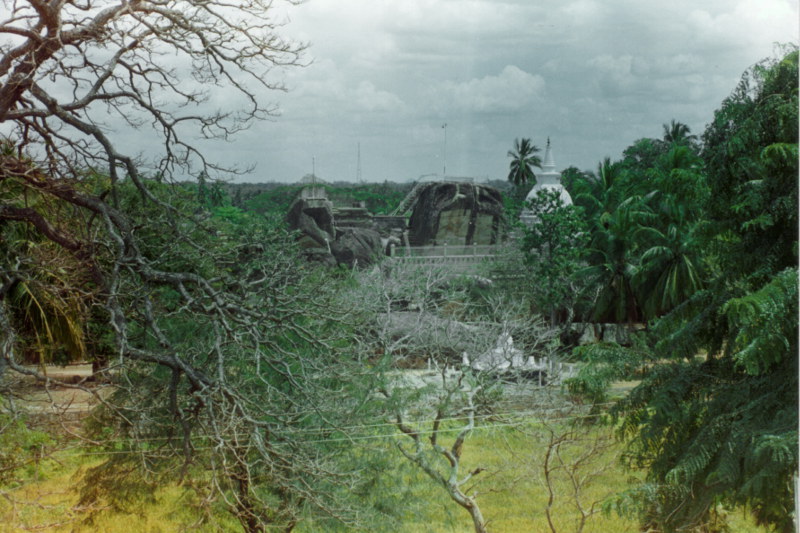The ruins of the ancient city are truly amazing. Anuradhapura used to be the capital city of Sri Lanka and during this time the kings went on a fervent building spree. Many of the structures built during this period are still standing. Anuradhapura is considered to be the most holy, important, and longest occupied of the ancient Sri Lankan cities. The city was originally built in 380 BC and played a part in Sinhalese life until the people relocated to Polonnaruwa in the late 10th century AD.
My day at the ruins was odd, to say the least. It was comprised of surreal scenes like seeing a monkey attack a woman for a bag of peanuts, watching soldiers with machine guns walking around periodically questioning people, and a young teenage boy who chased me through one section of ruins with his pecker in hand. Luckily, I was on my bike and able to get away as he (completely unbalanced in more ways than one) fell into a ditch!
Here is a brief history of some of the ruins and dagobas:
Mirisavatiya Dagoba: Legend has it that one day King Dutugemunu went to bathe in the Tissawewa. Before he went in he stuck his sceptre (which contained a relic of Buddha) in the ground. When he returned to retrieve his sceptre he could not pull it from the ground. He took this as a sign and built Mirisavatiya on that very spot.
Ruvanvelisaya Dagoba: This was the last temple that King Dutugemunu built and is considered to be his greatest masterpiece. He did not get a chance to see the finished Dagoba as he was stricken ill. His brother had the temple covered in bamboo and cloth so it looked like the temple was complete and King Dutugemunu’s last dying sight was his finished masterpiece.
Lankaramaya Dagoba: This degoba was built by King Walagamba, King Dutugemunu’s successor. There is speculation over whether or not King Walagamba is the King Vibishana mentioned in the Ramayana. In the legend, Rama reclaimed Sita from the evil Ravana and when he left Lanka he named Vibishana the rightful king of the country.
Abhayagiri: The name Abhayagiri means “fearless Giri.” As the story goes, in 103 BC King Valagambahu was forced out of Anuradhapura by Indian invaders. As he was leaving the city he was ridiculed by a Jain monk named Giri. Fourteen years later Valagambahu retook Anuradhapura and had the monk executed. King Valagambahu had the dagoba built on the spot where Giri’s hermitage originally stood.”
Isurumuniya Vihara: This is a rock temple that dates to the reign of King Tissa. It is famous for “The Lovers” sculpture. There is debate on who is being depicted in the sculpture. Some say it is of Prince Saliya and Asokamala. Prince Saliya renounced his throne after he fell in love with Asokamala, a commoner. Others believe it is a Hindu god and his consort.
Jethawanaramaya Dagoba: This impressive structure can be seen from just about everywhere in Anuradhapura and is thought to be an early centre of learning. It was originally built in the 3rd Century AD by the King Mahasena and is one of the largest brick structures in the world.
One final note, if you’ve been through my India posts, you’ll remember King Ravana from the Hindu Ramayana. In Hindu legends Sita is said to be one of the most beautiful of all women and in seeing her beauty, Ravana kidnapped her and took her across the ocean to Lanka and the Kindom of Anuradhapura where she remained a captive for a year until she was rescued by Rama.
